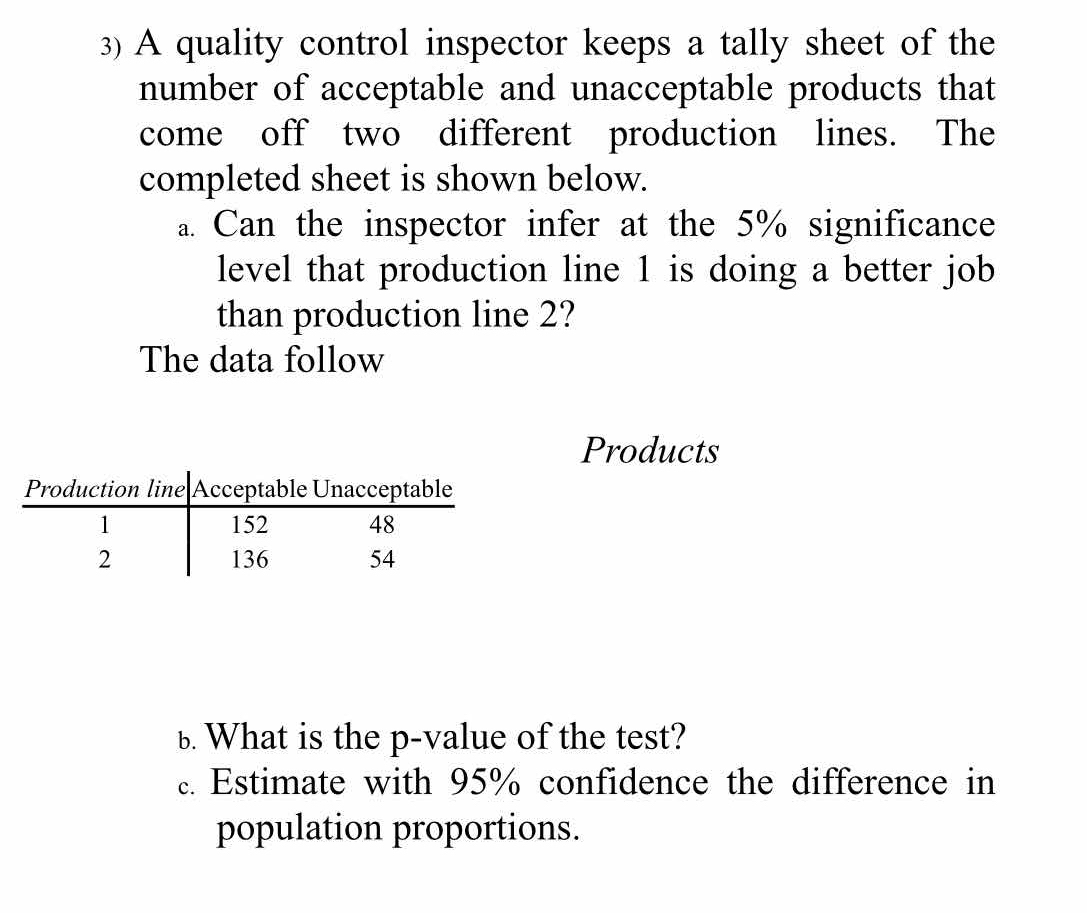A quality control inspector keeps a tally sheet of the number of acceptable and unacceptable products that come off two different production lines. The completed sheet is shown bel... A quality control inspector keeps a tally sheet of the number of acceptable and unacceptable products that come off two different production lines. The completed sheet is shown below. a. Can the inspector infer at the 5% significance level that production line 1 is doing a better job than production line 2? b. What is the p-value of the test? c. Estimate with 95% confidence the difference in population proportions.

Understand the Problem
The question presents a scenario where a quality control inspector is comparing the performance of two production lines based on the number of acceptable and unacceptable products. Part (a) asks whether, based on the given data and a 5% significance level, one can conclude that production line 1 is performing better than production line 2. Part (b) asks for the p-value of the test. Part (c) asks to estimate the difference in population proportions with 95% confidence.
Answer
a. No. b. $p \approx 0.1602$ c. $(-0.043, 0.1314)$
Answer for screen readers
a. No, we cannot infer at the 5% significance level that production line 1 is doing a better job than production line 2. b. The p-value of the test is approximately 0.1602. c. The 95% confidence interval for the difference in population proportions is $(-0.043, 0.1314)$.
Steps to Solve
-
Calculate the sample proportions of acceptable products for each production line. To do this, divide the number of acceptable products by the total number of products for each line. $p_1 = \frac{152}{152 + 48} = \frac{152}{200} = 0.76$ $p_2 = \frac{136}{136 + 54} = \frac{136}{190} \approx 0.7158$
-
State the null and alternative hypotheses. The null hypothesis ($H_0$) is that there is no difference in the proportion of acceptable products between the two production lines: $p_1 - p_2 = 0$. The alternative hypothesis ($H_1$) is that production line 1 is doing a better job than production line 2, meaning the proportion of acceptable products from line 1 is greater than that from line 2: $p_1 - p_2 > 0$. This is a one-tailed test.
-
Calculate the pooled proportion. The pooled proportion is used to estimate the standard error when testing the difference between two proportions. $p = \frac{152 + 136}{200 + 190} = \frac{288}{390} \approx 0.7385$
-
Calculate the test statistic (z-score). The z-score is calculated as follows: $z = \frac{(p_1 - p_2) - (0)}{\sqrt{p(1-p)(\frac{1}{n_1} + \frac{1}{n_2})}}$ $z = \frac{(0.76 - 0.7158)}{\sqrt{0.7385(1-0.7385)(\frac{1}{200} + \frac{1}{190})}}$ where $n_1 = 200$ and $n_2 = 190$ $z = \frac{0.0442}{\sqrt{0.7385 * 0.2615 * (0.005 + 0.00526)}}$ $z = \frac{0.0442}{\sqrt{0.19313 * 0.01026}} = \frac{0.0442}{\sqrt{0.001981}} \approx \frac{0.0442}{0.0445} \approx 0.993$
-
Determine the p-value. Since it's a right-tailed test ($p_1 - p_2 > 0$), the p-value is the probability of observing a z-score as high as or higher than the calculated z-score. Using a z-table or calculator, the p-value for $z \approx 0.993$ is approximately $1 - 0.8398 = 0.1602$.
-
Compare the p-value to the significance level. The significance level ($\alpha$) is 5% or 0.05. Since the p-value (0.1602) is greater than the significance level (0.05), we fail to reject the null hypothesis.
-
Calculate the confidence interval for the difference in population proportions. The formula for the confidence interval is: $(p_1 - p_2) \pm z_{\alpha/2} \sqrt{\frac{p_1(1-p_1)}{n_1} + \frac{p_2(1-p_2)}{n_2}}$ For a 95% confidence interval, $z_{\alpha/2} = 1.96$. $(0.76 - 0.7158) \pm 1.96 \sqrt{\frac{0.76(1-0.76)}{200} + \frac{0.7158(1-0.7158)}{190}}$ $0.0442 \pm 1.96 \sqrt{\frac{0.76 * 0.24}{200} + \frac{0.7158 * 0.2842}{190}}$ $0.0442 \pm 1.96 \sqrt{\frac{0.1824}{200} + \frac{0.2034}{190}}$ $0.0442 \pm 1.96 \sqrt{0.000912 + 0.001071}$ $0.0442 \pm 1.96 \sqrt{0.001983}$ $0.0442 \pm 1.96 * 0.0445$ $0.0442 \pm 0.0872$ The 95% confidence interval is $(-0.043, 0.1314)$.
a. No, we cannot infer at the 5% significance level that production line 1 is doing a better job than production line 2. b. The p-value of the test is approximately 0.1602. c. The 95% confidence interval for the difference in population proportions is $(-0.043, 0.1314)$.
More Information
The confidence interval includes zero, which further supports the conclusion that there may not be a significant difference between the two production lines.
Tips
A common mistake is using the incorrect formula for the test statistic or confidence interval. It is important to use the formulas specifically designed for comparing two population proportions. Another mistake involves using a one-tailed test when a two-tailed test is more appropriate, or vice versa. In this case, the problem specifies that we are testing if production line 1 is better than line 2, which indicates a one-tailed test.
AI-generated content may contain errors. Please verify critical information